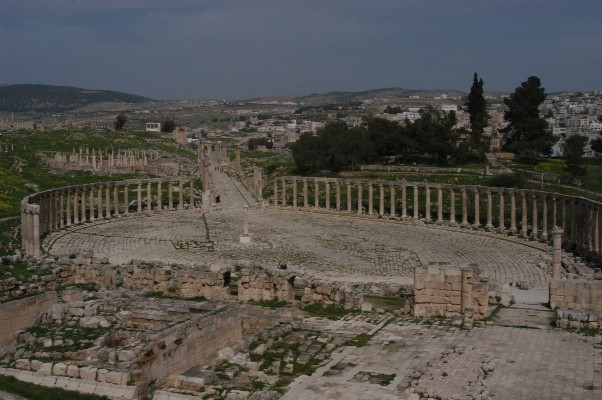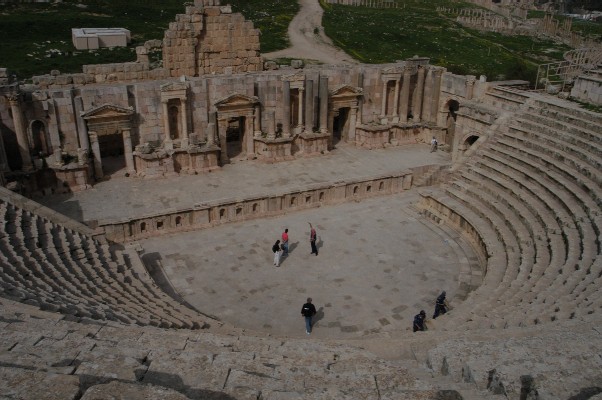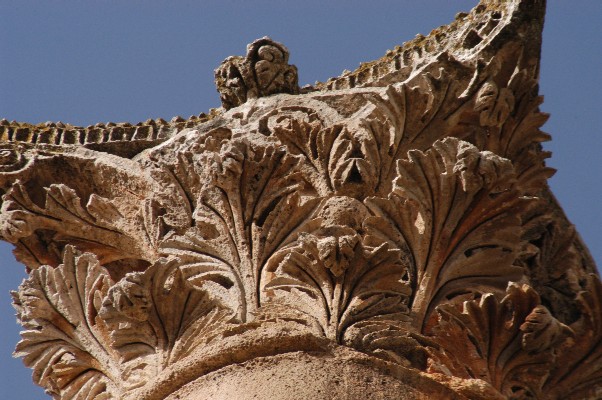February 28. AMMAN "Day Trip to Jerash" We caught the bus to Jerash in the morning and it was quick one hour ride to the ruins. Going north of Amman the countryside became more hilly and green. From the high road we could see out over the lovely valleys and lakes, a drastically different landscape to most of what we had seen in Jordan and the obvious reason why most of the country's population is clustered in the northwest corner. The city of Jerash that surrounded the Roman ruins was not anything special, just typical modern buildings of stone and concrete. But, the ruins dominated the city, covering an area almost equal to Jerash's modern downtown. more hilly and green. From the high road we could see out over the lovely valleys and lakes, a drastically different landscape to most of what we had seen in Jordan and the obvious reason why most of the country's population is clustered in the northwest corner. The city of Jerash that surrounded the Roman ruins was not anything special, just typical modern buildings of stone and concrete. But, the ruins dominated the city, covering an area almost equal to Jerash's modern downtown.
The city of Geresa (Jerash) was founded in 170 B.C. by the Greeks but became more important after it came under Roman control in 63 B.C. and was incorporated into the Decapolis, a group of ten cities that covered parts of present day Jordan, Syria and Israel, including Amman (then called Philadelphia). As part of the Province in Syria they were granted autonomy and it was at this time that Gerasa started to flourish and the basic town plan that survives today was started. It is uncertain whether or not these cities cooperated with each other as a league but they certainly shared a common history and culture. These cultural links were undermined by Emperor Trajan in 106 A.D. when he reorganized the territory and split the ten cities between the Province of Syria and the Province of Arabia and by the end of the 3rd century, when Diocletian split the Roman empire into east and west, any unity amongst the Decapolis cities was dead. However, under Trajan's Province of Arabia, Geresa experienced a boom and during the reign of Trajan's successor, Hadrian, it briefly became the absolute center of the Roman Empire.
Under the Byzantine Empire Jerash was Christianized and many churches were built in the fifth and sixth centuries but the city slowly lost its luster and vitality, finally falling to the Persian's in 614. The Persians only ruled in Jerash until the Muslims took over in 636, after which time the city began to fall into serious decline. The earthquake of 747 dealt the final blow and then Jerash was lost to the world for a thousand years. It was only at the beginning of the 19th century that the city was rediscovered and archeological investigation began. In 1879, the Ottoman authorities directed Circassian immigrants (Muslims expelled by the Russians from the Caucus region of the Black Sea) to settled in Jerash as they had done with Amman. The city still had a Circassian majority. in 614. The Persians only ruled in Jerash until the Muslims took over in 636, after which time the city began to fall into serious decline. The earthquake of 747 dealt the final blow and then Jerash was lost to the world for a thousand years. It was only at the beginning of the 19th century that the city was rediscovered and archeological investigation began. In 1879, the Ottoman authorities directed Circassian immigrants (Muslims expelled by the Russians from the Caucus region of the Black Sea) to settled in Jerash as they had done with Amman. The city still had a Circassian majority.
Not far from where the bus dropped us off we came upon the large Hadrian's Arch that marks the southern most point of the old city. Just beyond the arch stood the 244m long Hippodrome that once held about 15,000 people. It was small by Roman standards but will soon experience a cultural revival when it begins to host modern day chariot races. Both of these structures laid outside the walls that surrounded the core of the city and after passing the length of the Hippodrome we found the ticket office. We entered the city from the south gate and were immediately confronted by the impressively grand Oval Plaza, a stone paved area encircled by a colonnade. The plaza was a dramatic entrance to Jerash with the far end giving way to the Cardo, the old main boulevard. The plaza was the most outstanding feature of the ruins.
Coming from Egypt we were starting to feel the effects of being "ruined" out. As impressive as the ruins in Jersah where we were having a hard time generating the appropriate enthusiasm and found ourselves moving at a very slow pace. We hiked our way from the Oval Plaza to the Temple of Zeus that stood directly to the south. The monument was undergoing reconstruction but the view of the ruins from the hilltop was grand. The nearby South Theater was ranked as Jerash's most magnificent structure with steep tiered seating and perfect acoustics. Having been extensively restored it was a fine example of Roman-style theater architecture but it didn't provide the unique impact we felt when viewing the graceful Oval Plaza. We sat high up in the seats and watched tour groups come and go. One guide enthusiastically demonstrated the acoustics to his group by singing pop songs from the mid-point of the orchestra. He wasn't bad and provided an amusing sight; a man wearing a red keffiyeh, patterned headscarf, standing in the middle of an ancient Roman theater, reaching his arms our dramatically and singing loudly in English. We observed people crouching down to lean their heads into the circular indentations along the wall of the orchestra where they could whisper to each other and be heard clearly. We watched a woman climb to the top of the seats and, finding herself paralyzed by the height, started to scoot back down on her butt, stair by stair, but was rescued by a nice American man. appropriate enthusiasm and found ourselves moving at a very slow pace. We hiked our way from the Oval Plaza to the Temple of Zeus that stood directly to the south. The monument was undergoing reconstruction but the view of the ruins from the hilltop was grand. The nearby South Theater was ranked as Jerash's most magnificent structure with steep tiered seating and perfect acoustics. Having been extensively restored it was a fine example of Roman-style theater architecture but it didn't provide the unique impact we felt when viewing the graceful Oval Plaza. We sat high up in the seats and watched tour groups come and go. One guide enthusiastically demonstrated the acoustics to his group by singing pop songs from the mid-point of the orchestra. He wasn't bad and provided an amusing sight; a man wearing a red keffiyeh, patterned headscarf, standing in the middle of an ancient Roman theater, reaching his arms our dramatically and singing loudly in English. We observed people crouching down to lean their heads into the circular indentations along the wall of the orchestra where they could whisper to each other and be heard clearly. We watched a woman climb to the top of the seats and, finding herself paralyzed by the height, started to scoot back down on her butt, stair by stair, but was rescued by a nice American man.
Returning to the Oval Plaza we walked up the colonnaded main boulevard, the Cardo. It stretched some 800m long and was bisected by two major crossings. We passed the first intersection which was marked by a small circular plaza with four podia that created a square in the in the middle. Remnants of little shops that once stood along the outer edges of the plaza were still visible. Further up the Cardo stood a grand Nymphaeum, a huge semi-circle shaped public fountain dedicated to water nymphs that served to protect the city's water source. Water once poured off of the edge of the fountain into shallow basins on the street level. The Byzantines added a massive red granite bowl for catching water as well.
From the Nymphaeum we left the Cardo and climbed up to the Temple of Artemis complex, which would have once towered over the lower parts of the city. The temple's thick Corinthian columns were its most striking feature, not all surviving but the ornate leaves on the remaining column heads were now home to a small population of doves. It was here that our tour of Jerash came to an end. There were some more churches and other smaller structures to explore but we had covered the key buildings and had reached our maximum ruin consumption level. Rob and I split up to take different return routes. He went back to explore more of the Cardo while I walked down a path to the west that look me past a fairly large but un-restored church complex and dumped me out on the southern road that bisected the Cardo. We met in the Oval Plaza. We walked back to the intersection where the bus had left us that morning and picked up another bus to return to Amman. over the lower parts of the city. The temple's thick Corinthian columns were its most striking feature, not all surviving but the ornate leaves on the remaining column heads were now home to a small population of doves. It was here that our tour of Jerash came to an end. There were some more churches and other smaller structures to explore but we had covered the key buildings and had reached our maximum ruin consumption level. Rob and I split up to take different return routes. He went back to explore more of the Cardo while I walked down a path to the west that look me past a fairly large but un-restored church complex and dumped me out on the southern road that bisected the Cardo. We met in the Oval Plaza. We walked back to the intersection where the bus had left us that morning and picked up another bus to return to Amman.
We entered the city via a familiar roadway, marked by a busy McDonald's, and our stomachs reminded us that they were hungry. We got off of the bus before Abdali station and willingly sought out the fast-food laden area of Shmeisani, an apparent foreigner ghetto of fast-food restaurants, Jordanian and Western cafes and some high end designer shops. It was not the city's most scenic spot but some recent developments showed that more improvements were on the way. We waived between KFC and Burger King but ultimately gave in to the latter. It was a disappointing meal by even fast food standards but a welcomed changed from shwarma on the 2nd circle or hotel room service. We followed dinner with some cappuccinos at a nearby cafe. They ran a swift business and had order lined up for places all over Amman. We asked them to confirm how to make a proper Jordanian coffee and the man politely showed us the different colored coffee beans and how much cardamom they ground in to give the coffee its distinctive flavor. From Shmeisani it was a downhill walk to Abdali and since the weather had warmed substantially since we had arrived in Ammn we enjoyed a pleasant stroll, a couple of mad dashes across streets, back to the hotel. standards but a welcomed changed from shwarma on the 2nd circle or hotel room service. We followed dinner with some cappuccinos at a nearby cafe. They ran a swift business and had order lined up for places all over Amman. We asked them to confirm how to make a proper Jordanian coffee and the man politely showed us the different colored coffee beans and how much cardamom they ground in to give the coffee its distinctive flavor. From Shmeisani it was a downhill walk to Abdali and since the weather had warmed substantially since we had arrived in Ammn we enjoyed a pleasant stroll, a couple of mad dashes across streets, back to the hotel. |
GREECE
Athens
Jan 27-Feb 4
EGYPT
Cairo
Feb 4
Feb 5
Feb 6
Feb 7
Aswan
Feb 8
Feb 9
Feb 10
Luxor
Feb 11
Feb 12
Feb 13
Feb 14
Feb 15
Nuweiba
Feb 16-17
JORDAN
Petra
Feb 18
Feb 19
Feb 20
Feb 21
Amman
Feb 22
Feb 23-24
Feb 25
Feb 26
Feb 27
Feb 28
Feb 29-Mar 1
Dead Sea
Mar 2
Mar 3
ISRAEL
Eilat
Mar 4
EGYPT
Cairo
Mar 5
Mar 6
Mar 7
Mar 8
GREECE
Athens
Mar 9
Santorini
Mar 10
Mar 11
Mar 12-13
Crete
Mar 14
Mar 15-16
Mar 17-21
Athens
Mar 22
|

